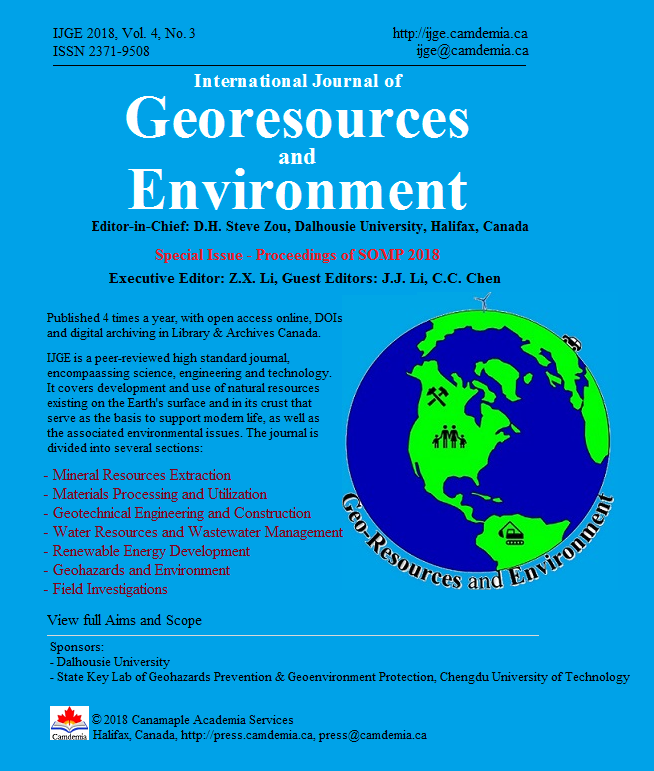Evaluating the Strength and Performance of Backfill Support in Deep Level Gold Mines
DOI:
https://doi.org/10.15273/ijge.2018.03.026Keywords:
CCT, FPT, UCS, backfill, deep level gold mines, supportAbstract
The backfill operations at the deep level gold mine consist of a Cyclone Classified Tailings (CCT) Plant as well as a Full Plant Tailings (FPT) Plant with both producing cemented backfill. Due to the high demand of backfill at the mine, including a backlog of voids that need to be filled, both the CCT and FPT Plants are being operated at the moment. The mine will require an increased capacity of backfill going forward, with monthly throughputs in the order of 200 000 to 250 000 tonnes being required. The current mining methods includes destress cuts, long hole stoping as well as drift and fill mining with cemented backfill as a support medium. These concerns have led to the review of the entire backfill operations of the mine with a need for optimising, reducing costs and reducing operational complexity going forward. The research provides strength test work (solids density, particle size distribution, slurry pH, temperature, conductivity, freely settled bed packing concentration, permeability, particle micrographs, water quality, mineralogy, boger slump tests, cement mortar tests (ISO bars), and unconfined compressive strength (UCS) tests) and audit the current backfill operations at the mine. The data showed that both materials had similar top particle sizes of approximately 500 μm. The CCT has a d30 and d10 of 63.4 and 18.2 μm, respectively, compared to the FPT with a d30 and d10 of 13.1 and 3.1, respectively, which is significantly finer. The freely settled bed packing concentration by volume was calculated from the volume of the freely settled bed formed by a known volume of solids. A slurry sample was allowed to settle for 24 hours in a measuring flask. The actual solids volume was determined from the dry mass of material and the solids density. The results were as follows: CCT 45.2 %v (69.1 %m) and FPT 40.0 %v (63.8 %m).Downloads
Published
Issue
Section
License
Copyright, Terms and Conditions
The International Journal of Geohazards and Environment (the Journal) is published by Canamaple Academia Services (the Publisher) online with open access, under a Creative Commons Attribution-Noncommercial license (CC-BY-NC) (http://creativecommons.org/licenses/by-nc/4.0/). Authors (the Authors) submitting papers (the Work) for publication in the Journal automatically agree to the following terms and conditions.
1. Under the license (CC-BY-NC), Authors give permission for others to share and reuse the Work, as long as the original source and author(s) are properly cited (i.e. a complete bibliographic citation and link to the Journal website) and the material is not used for commercial purposes. Any sharing or reuse must however indicate the original CC-BY-NC license terms of the work.
2. Authors transfer and assign to the Publisher all copyright in and to the Work. However Authors retain all proprietary rights except the copyright, related to the Work and also retain the rights a) to use, reproduce, distribute, and publicly display the Work in any medium in connection with the Authors‘ academic and professional activities, such as teaching, presentations and lectures, b) to create derivative works from the Work and to make full use of the Work in future research and publications, c) to authorize others to make any non-commercial use of the Work, d) to make both the pre-published and final-published versions available online in institutional and/or disciplinary repositories or on their own websites with a citation and link to the original paper published in the Journal.
3. Authors warrant that the Work is their original work, it is not copied from anywhere or anyone else, they are totally responsible for the authenticity, originality, validity and accuracy, and the facts and views are their own, that the Work contains no matter which is defamatory or infringes any literary or proprietary rights, intellectual property rights, or any rights of privacy, and that the Work has not been simultaneously submitted to any other journals or publishers. Authors further agree that their manuscripts whether accepted or rejected will not be returned and the rejected manuscripts will be disposed at the journal editor's discretion.
Disclaimer: The Publisher, the Journal and the editors accept no responsibility for statements or opinions expressed by authors. Use of information and materials in the Journal is the sole responsibility of users.


